Eagle Transporter
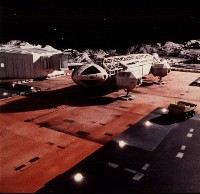
The Eagle is the iconic image of Space 1999. Brian Johnson's design is clearly influenced by 2001 A Space Odyssey; in turn, it influenced Star Wars and later science fiction (George Lucas visited the SFX studios during filming). Johnson says: "The moonbus in 2001, when Doug Trumbull and I were working on it, way back in '64, '65, I decided that it should look nicer if we had bits of plastic kit and girdering stuff all over it.

The Eagle was originally named the MTU (Multiple Transportation Unit), "a workhorse, a thoroughly utilitarian spacecraft." Here is an early Chris Foss version, based on Brian Johnson's design. Johnson told TV Sci-Fi Monthly in 1976 "The Eagle was based on a kind of grass-hopper shape which just sort of grew. It was considerably shorter before we started filming, but later it elongated." The Foss painting here shows the command module, leg pods and framework, but there is no discernible passenger module section.



These plans, labelled "Revised MTU 26 8 73" (26th August 1973) show the near-final form of the Eagle. The drawings show some evolution in the design- the introduction of the "M" pattern at the ends of the top spine, and the shape of the Eagle windows, the three vertical rocket engines under the passenger module. These rough plans were then turned into engineering designs by draughtsman Michael Lamont (later assistant art director on the Star Wars films and many James Bond films) and sent to Space Models, where the model was built in 3 different scales by company director "Wag" Evans, and model makers Gary Dickens, David Seymour and John Phillips.

The original sizes built by Space Models in 1973 were 44" (112cm, approximately 1:24 scale), 22" (56cm) and 11" (28cm). As the series progressed, other models were built- two more 44" Eagles, another 11" Eagle, and a small 5" (14cm) Eagle. This publicity shot from mid-Year 1 shows the four scales from 44" to 5".



Two of the 3 44" Eagles, the original 22" Eagle, and a replica 5" Eagle, at the Psycon convention in 1992.
 |
These are the 11" and 5 1/2" Eagles. Note the smaller Eagle's passenger module is red on the side; this model was seen in distant shots of Commissioner Simmonds Eagle over the Moonbase in Breakaway. |
 |
Martin Bower's 22 inch Eagle (only seen in publicity shots for Bringers Of Wonder), with two 11 inch Eagles and the 5 1/2 inch, which here has lost one pod. The second 11 inch Eagle has very odd framework. |
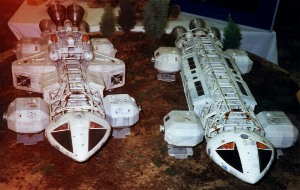 |
Three Eagles were built in the largest 44" size (actually 43 1/4 inches long, 1.1m). The scale is about 1:24. There was a larger section made to 1:8 scale (seen with the laser turret and lowering model astronauts); if this had been completed, the model would have been 10' 9 3/4" long (3.29m). These are the second and third models. The central pods are detachable; the booster pod is first seen in Guardian Of Piri and featured prominently in The Metamorph and All That Glisters. |


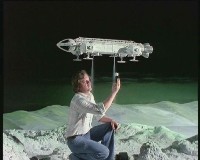
Filming the model (more photos). The rocket jets under the passenger module of the 44 inch models were functional. Freon gas canisters were built into the passenger module, and when the valve was opened, freon jetted out beneath the Eagle. To open the valve, an electric current was sent down the wires suspending the model. The Eagle was suspended by two wires, attached to each end of the top spine. Apart from the initial episodes, these two end bars have black insulating tape around them, to stop the wires shorting through the brass.

A rear view of Eagles 2 and 3. Eagle 3 also has a top mounted booster seen in The Metamorph (this is a replica of the original). Another booster (from New Adam New Eve) can be seen in the Eagle components page.

The command module and side leg pods can be disassembled; this was done for maintenance and occasionally for "damaged" Eagles. The framework is made up of 55 feet (16.7 metres) of quarter-inch brass tubing (steel in the third Eagle).

The Command Module detached. The outer frame ring from the main body is fixed to the command module, and simply slots in. There are two screws on the top, which hold the back of the cone (with the Revell Gemini astronauts) to the front.
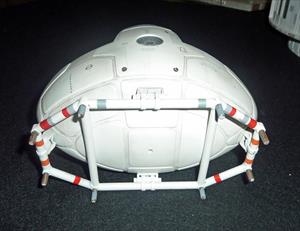

The rear door doesn't have any resemblance to the interior set door. There is slight detailing differences between Eagle 1 and 2 command modules, shown here.


The main body. The Eagle command module "door" is merely a rectangle.
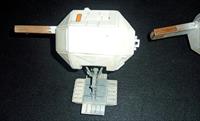

You can also view the Eagle laser turret in the small models gallery.
Contents copyright Martin Willey